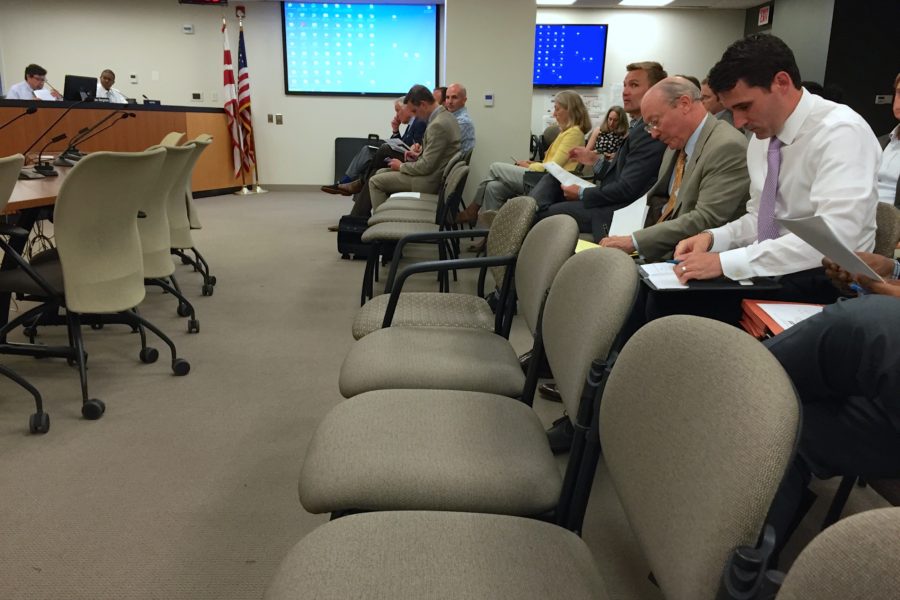After four contentious hearings and more than three months, artists have agreed to vacate the D.C. building known as Union Arts next year. The agreement removes a major obstacle to the development of an arts-focused “boutique” hotel at the 411 New York Ave. NE location.
The city’s Zoning Commission met Monday evening to set up the final steps for approval of the process. Unlike past hearings, there was not a large crowd.
In packed hearings in February, artists and their supporters testified in strong opposition to the development and talked of Union Arts’ importance in D.C.’s artistic community. Union Arts is home to arts studios, music rehearsal and performance spaces, and the vintage shop Nomad Yard Collectiv.
The artists, who said between 70 and 100 people use the space, claimed they were being displaced. The building’s former owner said the artists’ current situation was financially untenable.
The hearings focused on whether to approve a change from C-M-1 to C-3-C zoning designation, allowing developers to build the planned 11-story hotel, which could have as many as 178 rooms. D.B. Lee Development Construction and Brook Rose Development acquired the building in June 2015.
On Monday, the commission voted to take “proposed action” on the project. The next step is to take “final action,” which D.B. Lee’s president, Dennis Lee, thinks could happen in July or September. With the dispute with the tenants resolved, the commissioners’ main concern was a technicality involving a minimum required square footage of the lot.
Many of the artists’ demands were things that the commission had “no jurisdiction” over, commission Chairman Anthony Hood said.
“I think it’s very valuable to the city and I hope we can find ways to keep the artists here,” Hood said. “But in this case I thought that the party in opposition … was asking for something that I just don’t see.”
Settlement and endgame
The organized opposition paid off, at least financially. Artists and their lawyer negotiated a settlement with the developers to withdraw their opposition in turn for getting relocation money.
In a document dated May 12, the representative of the Artists Union, Chris Otten, rescinds “411 Artists Union status as a party in opposition” to the project.
Earlier this year developers wanted the artists to vacate by September 2016, but that has been extended to April 2017. Nomad Yard owner Desirée Venn Frederic says occupants are paying increased rent in turn for an extended stay.
A document from the developer’s attorney submitted on May 18 outlines terms of a settlement agreement from early May. Developers agree to “relocation assistance” to tenants in the amount of $2 per square foot of their studio space. The document lists eight separate units covered under the agreement, of varying square footage between 440 and 5,000. Some of these units are shared by multiple people. The developer also agrees to make “reasonable good faith efforts” to help artists find new studio space and manage construction of a new space “at no cost to the Artists.” Other takeaways for the artists include assistance with grant education and a seat on the board of directors of the new hotel’s arts program. Artists agree to not oppose the project.
Many of the artists who have been highly involved in organizing opposition — including Frederic, Luke Stewart, Graham Boyle and Micheline Klagsbrun — signed the agreement themselves or by proxy.
“I’m satisfied in the sense that we’re now able to redirect our energy and our focus to identifying a more permanent home,” Frederic says. She says so far she has not had much luck finding a new space for Nomad Yard.
But Frederic says the relationship between the artists and the developers has improved in the last two or three months. “They are trying to work with us at this point, and I have to acknowledge that,” she says. After the outpouring of support at hearings earlier this year, “they truly understand the value that we present.”
D.B. Lee president Dennis Lee has emphasized the uniqueness of the new arts-focused hotel, and has said developers need artists to lend the project artistic “authenticity.”
The new program
D.B. Lee outlined the hotel’s proposed arts program in a “proposed findings of fact and conclusions of law,” submitted May 31. Lee says his group wrote the 43-page document with the intention that the Zoning Commission would mostly adopt it. He says the commission typically doesn’t want to take the time to write it itself.
The draft document details, for the hotel arts program: a minimum 20-year commitment; 544 square feet of classroom space; 14,700 square feet of exhibition space, a requirement for 40 percent of “arts programming” members to be Ward 5 residents with free or discounted membership; 2,600 square feet of artist studio space rented at $20 a square foot; and 800 square feet of artist studio and retail space rented at $40 a square foot.
With the settlement agreement, Lee writes he that he is “now hopeful that we can go back to work on a truthful pursuit of keeping and building a sustainable art culture in our city. There are a lot of movements to do that and they are very positive.”
But as they have been saying for months, artists still think the city is not paying attention to their needs in general. That’s why, some said, their protests were more against what they see as the city’s pro-development policies, rather than against this particular project.
Frederic says artists are “asking that the city live up to its word, found in numerous planning documents that they’ve written, expressing how important the creative and cultural economy is to the vibrancy of the District of Columbia.”


